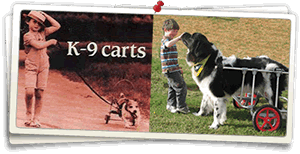We Are K-9 Cart Company East. We Make Pet Wheelchairs.
But why do dogs need wheelchairs? There are many reasons that they may either lose their mobility in their front or back legs. Wheelchairs provide a great way for a dog with weakness or paralysis of the limbs that still has a good mental attitude to be mobile and remain man’s best friend.
Common reasons for dogs to need wheelchairs include:
- Intervertebral Disc Disease (IVDD)
- Ruptured discs
- Degenerative Myelopathy (DM)
- Neurologic disease
- Fractured backs
- Fibrocartilagenous emboli (FCE)
- Traumatic injuries (e.g., hit by car, fall)
- Birth defects
- Rehab device after orthopedic surgery on hips, knees, or elbows.
Normally, young dogs with arthritis, hip dysplasia, or amputation of a single limb, will NOT need dog wheelchairs. However, dogs with arthritis or degenerative joint disease (DJD), including hip dysplasia or elbow problems, may find that a wheelchair can assist with mobility as the body weakens as the pet ages.
For most dogs, it is beneficial not to wait to get a wheelchair. With disuse, muscles weaken and atrophy and joints become stiffer making it more work to regain strength. Since dogs come in so many shapes and sizes, a dog cart should be custom made to fit your pet perfectly. One size fits all designs probably will fit only a few animals. Ideally, a wheelchair will have adjustments in height, width, and length, since it is often difficult to measure a dog that is paralyzed or unable to stand on its own.
Wheelchairs should be constructed differently to support a rear limb disability than a front limb one. Slings or stirrups for the hind feet are often beneficial in dogs that would other drag their feet in a cart and cause sores from them rubbing on the ground. Newer wheelchairs provide handheld harnesses that can be used without the wheelchair for short walks or to assist in placing larger dogs into a dog kart. Amputees will require special padding to prevent sores as well.
It is especially important that the wheelchair keeps the dog in a normal posture so that extra weight is not shifted to the remaining mobile limbs. In addition, lightweight construction with materials such as aluminum tube and foam-filled tires mean that wheelchair is easy to move for the dog and carry by the owner.
So you are ready to order a dog wheelchair, but what next?
- First, investigate different dog wheelchair manufacturers and measure your dog according to their instructions. Ask your vet to help if you are unsure of your measurements.
- Call the manufacturer and make sure that a dog cart is right for your dog. Also, make sure that your wheelchair can be produced in a reasonable time frame.
- Visit the dog wheelchair shop for a final fitting if possible. Think about it. Custom orthodotics for your feet are not usually purchased mail order!
- Once you have had time to adjust your dog to the cart, send pictures of the front, side, back, and top view to the manufacturer to see if they have any suggestions to improve the fit (or just to show off your dog.)
The most important consideration when buying a dog wheelchair is not to have overly high expectations. If your pet is weak in all four limbs, a wheelchair is not going to turn the clock back 10 years on your dog. If you are not sure whether a wheelchair is right for you, talk to the manufacturer, look at pictures and video on the website, exchange email with satisfied owners, or ask other wheelchair owners their thoughts on a forum or bulletin board. Certainly, many dogs with weakness in either the front or hind limbs do extremely well in dog carts as is seen by the over 35,000 wheelchairs that have been sold.
